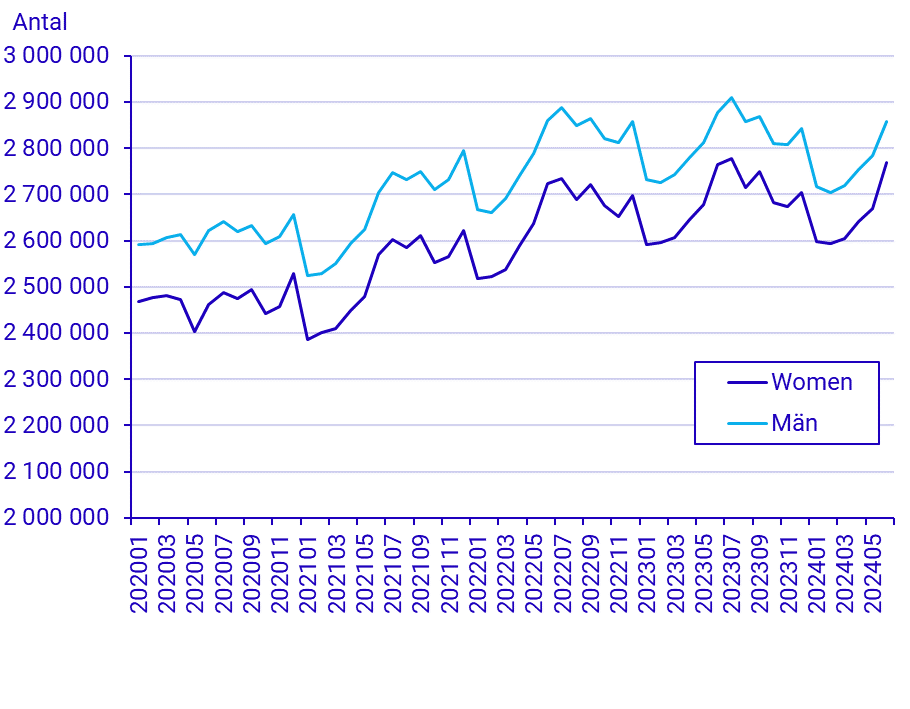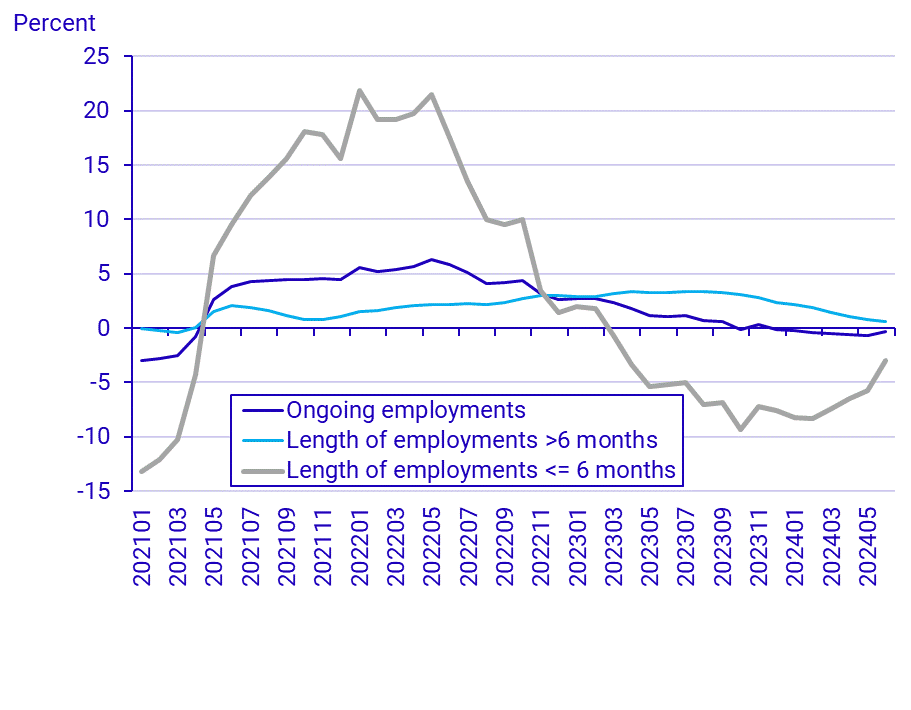Employment April - June 2024
Employments continues to decrease for April, May, and June 2024
Statistical news from Statistics Sweden 2024-09-04 8.00
The number of ongoing employments in June 2024 amounted to 5 627 000. This represents a decrease of 0.3 percent compared to June 2023. Distributed by gender, the number of women increased by 0.2, while the number of men decreased by 0.7 percent. Worked time is decreased by 3.4 percent compared to the same period the previous year and amounts to 635.4 million of hours worked in June 2024.
Ongoing employments
The number of ongoing employments decreased in June 2024 by 16 000 compared to the same period in 2023, amounting to 5 627 000. This corresponds to a decrease of 0.3 percent. Distributed by gender, 2 857 000 of the employments were held by men and 2 770 000 by women.
In April and May 2024, the number of ongoing employments also decreased compared to the same period the previous year, by 0.6 percent in April and 0.7 percent in May.

Length of employment
Out of the 5 627 000 ongoing employments in June 2024, 4 270 000 employments had been ongoing for more than six months, while 1 357 000 had been ongoing for six months or less. Employments lasting more than six months have increased by 0.6 percent, while employments lasting six months or less have decreased by 3.0 percent compared to June 2023.
A similar trend is observed for April and May 2024 compared to the same period in 2023, where employments lasting more than six months has increased by 1.1 and 0.8 percent, respectively. Employments lasting six months or less decreased by 6.5 and 5.7 percent, respectively.
As shown below, employments lasting six months or less tend to exhibit the largest percentage changes, with a notable decline in May 2022. Employments lasting more than six months do not show the same fluctuations, although a slight decrease from September 2023 can be observed.

Sector and industrial classification
In the general government sector, there were 1 717 000 ongoing employments in June 2024, an increase of 1.7 percent compared to June 2023. For April and May, ongoing employments in the general government sector increased by 0.1 and 0.4 percent, respectively, compared to the same period the previous year.
In the business sector, there were 3 738 000 ongoing employments in June 2024, representing a decrease of 1.1 percent compared to June 2023. For April and May, the decreases were 0.9 and 1.2 percent points, respectively.
Worked time
The total number of hours worked in June 2024 amounted to 635,4 million, which is a decrease of 3,4 percent compared to June 2023. In contrast, April and May show an increase of 0,9 and 3,7 percent, respectively, compared to the same period the previous year.
Flow in employments
Changes in employments are reported according to the flows of new employments, resumed employments, interrupted employments and re-interrupted employment.
For April, May, and June 2024, the number of terminated employments decrease compared to the same period the previous year, while resumed employments is increased and the changes for started employments and re-terminated employments varied across the months.
Sickness absence
In June 2024, sick pay from employers was paid for a total of 1 655 000 compensation days and the ongoing sick periods amounted to 601 000. In April and May there were a total of 2 295 000 and 1 986 000 compensation days, respectively, while the ongoing sick periods amounted to 797 000 and 710 000, respectively.
| April 2024 | May 2024 | June 2024 | Change since April 2023 | Change since May 2023 | Change since June 2023 | |
|---|---|---|---|---|---|---|
| Ongoing employments | 5 396 000 | 5 454 000 | 5 627 000 | ‑0.6 | ‑0.7 | ‑0.3 |
| Women | 2 641 000 | 2 669 000 | 2 770 000 | ‑0.2 | ‑0.3 | 0.2 |
| Men | 2 755 000 | 2 785 000 | 2 857 000 | ‑0.9 | ‑1.0 | ‑0.7 |
| Length of employments >6 months | 4 276 000 | 4 276 000 | 4 270 000 | 1.1 | 0.8 | 0.6 |
| Women | 2 073 000 | 2 075 000 | 2 076 000 | 1.8 | 1.5 | 1.4 |
| Men | 2 203 000 | 2 201 000 | 2 194 000 | 0.5 | 0.2 | ‑0.1 |
| Length of employments <=6 months> | 1 120 000 | 1 178 000 | 1 357 000 | ‑6.5 | ‑5.7 | ‑3.0 |
| Women | 568 000 | 594 000 | 694 000 | ‑6.8 | ‑6.4 | ‑3.2 |
| Men | 552 000 | 584 000 | 663 000 | ‑6.3 | ‑5.0 | ‑2.7 |
| April 2024 | May 2024 | June 2024 | Change since April 2023 | Change since May 2023 | Change since June 2023 | |
|---|---|---|---|---|---|---|
| Started employments | 197 000 | 228 000 | 312 000 | ‑7.3 | ‑5.6 | 1.0 |
| Women | 95 000 | 110 000 | 157 000 | ‑9.2 | ‑6.9 | 2.1 |
| Men | 101 000 | 118 000 | 155 000 | ‑5.5 | ‑4.3 | ‑0.1 |
| Resumed employments | 167 000 | 163 000 | 198 000 | 2.9 | 1.1 | 4.7 |
| Women | 84 000 | 81 000 | 106 000 | 2.2 | ‑0.6 | 5.5 |
| Men | 83 000 | 82 000 | 92 000 | 3.6 | 2.9 | 3.7 |
| Terminated employments | 206 000 | 237 000 | 245 000 | ‑3.4 | ‑2.6 | ‑2.9 |
| Women | 101 000 | 115 000 | 116 000 | ‑4.5 | ‑4.0 | ‑3.9 |
| Men | 106 000 | 122 000 | 128 000 | ‑2.2 | ‑1.3 | ‑2.1 |
| Re-terminated employments | 87 000 | 97 000 | 91 000 | 1.2 | 0.6 | ‑2.0 |
| Women | 43 000 | 49 000 | 45 000 | 1.2 | 0.5 | ‑2.7 |
| Men | 44 000 | 48 000 | 46 000 | 1.2 | 0.6 | ‑1.3 |
| Number of compensations days per employment | Number of ongoing sickperiods per employment | ||||||
|---|---|---|---|---|---|---|---|
| April 2024 | May 2024 | June 2024 | April 2024 | May 2024 | June 2024 | ||
| Total | 0.42 | 0.36 | 0.29 | 0.15 | 0.13 | 0.11 | |
| Women | 0.49 | 0.42 | 0.34 | 0.17 | 0.15 | 0.12 | |
| Men | 0.36 | 0.31 | 0.25 | 0.12 | 0.11 | 0.09 | |
| Buisness sector | 0.38 | 0.32 | 0.28 | 0.13 | 0.11 | 0.10 | |
| Central government | 0.31 | 0.27 | 0.20 | 0.10 | 0.09 | 0.07 | |
| Regions | 0.53 | 0.47 | 0.37 | 0.19 | 0.18 | 0.14 | |
| Municipalities | 0.60 | 0.52 | 0.38 | 0.21 | 0.19 | 0.14 | |
| Non-profit institutions serving households | 0.27 | 0.23 | 0.15 | 0.09 | 0.07 | 0.05 | |
Definitions and explanations
Employments (ANST) consists of two parts. One part is register-based and is based on employer declarations at the individual level (PAYE) collected by the Swedish Tax Agency. The second part consists of the Sickness Absence during the Sick Pay Period (SuS), a sample survey where Statistics Sweden collects the data from employers.
The purpose of the register-based part is to depict the state of the labour market and its development over time. The statistics are used, among other things, for economic forecasts and are part of the European Union's labour market statistics.
The variable worked time is not entirely register-based; instead, it is derived from a model.
The purpose of SuS is to highlight sickness absence during the sick pay period, which is the first 14 days of sickness absence funded by the employer. The statistics are used for forecasts, analyses, and decision-making.
Feel free to use the facts from this statistical news but remember to state Source: Statistics Sweden.
